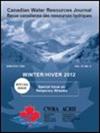加拿大人愿意为清洁地表水和地下水支付多少费用?加拿大非市场估价文献的荟萃分析
IF 0.9
4区 环境科学与生态学
Q3 WATER RESOURCES
引用次数: 3
摘要
摘要对加拿大三十年来的非市场水质评估(NMWQV)研究进行了分析,以生成一个通用的利益传递函数。与加拿大关注水和荒野娱乐的大量评估文献相反,与水质相关的研究数量有限。NMWQV研究缺乏共同的设计,包括一致遵守加拿大特定的水质阶梯(WQL)。尽管数据具有高度的异质性,但从文献中提取的值在将其与未来WQL的资源联系起来时显示出递增的阶跃函数。元回归模型(MRM)解释了基于水资源类型、人口和方法特征的价值估计的很大一部分变化。基线水质和水质变化的大小是估计非市场价值的重要决定因素。在相对平均预测误差不超过20%的情况下,估计的MRM的预测能力很高。因此,它们是在制定与政策相关的水质评估模型方面迈出的重要一步。然而,显然需要在加拿大的水资源背景下制定更加连贯的非市场估价准则。本文章由计算机程序翻译,如有差异,请以英文原文为准。
How much are Canadians willing to pay for clean surface and ground water? A meta-analysis of the Canadian non-market valuation literature
Abstract Three decades of non-market water quality valuation (NMWQV) studies in Canada are analyzed to generate a generic benefits transfer function. Contrary to the large valuation literature focusing on water and wilderness-based recreation in Canada, the number of studies related to water quality is limited. NMWQV studies lack a common design, including consistent adherence to a Canada-specific water quality ladder (WQL). Despite the high degree of data heterogeneity, values extracted from the literature show an increasing step function when relating them to the Resources for the Future WQL. Meta-regression models (MRMs) explain a large share of the variation in value estimates based on the type of water resources, population and methodological characteristics. Baseline water quality and the size of the water quality change are significant determinants of the estimated non-market values. With a relative mean prediction error of no more than 20 percent, the predictive power of the estimated MRMs is high. As such, they are an important step forward in the development of a policy-relevant water quality valuation model. However, there is a clear need for the development of more coherent non-market valuation guidelines in the Canadian water context.
求助全文
通过发布文献求助,成功后即可免费获取论文全文。
去求助
来源期刊

Canadian Water Resources Journal
WATER RESOURCES-
CiteScore
2.90
自引率
5.90%
发文量
17
审稿时长
>12 weeks
期刊介绍:
The Canadian Water Resources Journal accepts manuscripts in English or French and publishes abstracts in both official languages. Preference is given to manuscripts focusing on science and policy aspects of Canadian water management. Specifically, manuscripts should stimulate public awareness and understanding of Canada''s water resources, encourage recognition of the high priority of water as a resource, and provide new or increased knowledge on some aspect of Canada''s water.
The Canadian Water Resources Journal was first published in the fall of 1976 and it has grown in stature to be recognized as a quality and important publication in the water resources field.
 求助内容:
求助内容: 应助结果提醒方式:
应助结果提醒方式:


